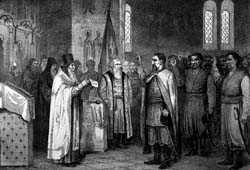Pereyaslav in the Focus of History – Or Bidding Far ewell to Myths

Historical myths are compared to a sweet poison and with reason. With the passage of time (especially when such myths are enforced by a totalitarian regime), a nation finds itself subconsciously but inexorably dependent on them, the way one gets on the needle and is hooked. The myth about the Council [Treaty] of Pereyaslav and about the Ukrainian people and its “reunification” with the Russian big brother, something the Ukrainians had supposedly dreamed about for centuries, was systematically and skillfully kindled for centuries, first by the tsarist and then the Russian Empire.
Until we Ukrainians succeed in refuting this myth and seeing that “historic” occurrence in Pereyaslav for what it actually was, we will never achieve our own national renascence. There is but one road leading to this goal: the truth of historical facts, the language of documents. That is why the appearance in print of the fundamental Pereyaslavska rada 1654 roku [The Pereyaslav Council of 1654), written by a team of historians, published by Smoloskyp, and ceremoniously presented in Kyiv, December 1, marked a significant event in Ukraine’s cultural life.
Prepared by an editorial board headed by Pavlo Sokhan, Corresponding Member of the National Academy of Sciences of Ukraine, approved for publication by the Academic Council of the Hrushevsky Institute of Archeography and Source Study in collaboration with the Canadian Institute of Ukrainian Studies and the Shevchenko Scientific Society in the USA, this monograph is valuable primarily as the first scholarly attempt to collect and analyze works by classics (little or totally unknown to the general public) and modern researchers. Among them are Mykhailo Hrushevsky, Mykhailo Drahomanov, Vyacheslav Lypynsky, Dmytro Dontsov, Mykhailo Braichevsky, Frank Sysyn, and Oleksandr Ohloblin — 870 pages in all.
Academician and People’s Deputy Mykola Zhulynsky, presiding over the presentation, noted in his address that the thinking Ukrainians, on the eve of the 350th anniversary of the Pereyaslav Council, are seeking answers to complex questions, namely what exactly happened three and a half centuries ago; what the Ukrainian people will celebrated in conjunction with the well-known presidential edict, the public attitude to it is anything but definite. Correct answers can be found only in the context of European (particularly diplomatic) history of that period, Khmelnytsky’s contacts with Sweden, the Crimea, Transylvania, and German duchies...One further has to bear in mind that the original text of the treaty composed by the Ukrainian side in Pereyaslav has not survived, and that Moscow “editors” are known to have repeatedly “corrected” it, and not to the benefit of Ukraine, while ruthlessly deleting any dubious passages.
As for the “reunification of two fraternal peoples” in Pereyaslav, it is necessary to point out the difference between the Ukrainian and Muscovite mentalities at the time. The new book contains an article by Mykhailo Hrushevsky in which he writes, “Talking about the Pereyaslav Treaty between Bohdan Khmelnytsky and Moscow, it was what we know today as a convention, an international instrument regulating relationships between two independent states, to which both these states agreed; a constitutional charter establishing relations between Ukraine, it volunteering to subject itself to the Muscovite tsar, and the tsar as a sovereign and guarantor of its rights and freedoms. However, at that time, and under those conditions, such treaties were concluded in different formats. The Cossacks were accustomed to appreciating hard facts, rather than privileges committed to paper. In their relations with the Polish governments, they referred to the rights and liberties acknowledged by kings, but the said rights and freedoms were not actually [legally] sealed by any resolutions of the Sejm or by royal letters of privileges but were the result of Cossack practices, something they gained themselves. On the other hand, the Muscovite government, acting in keeping with its own tradition, above all tried to raise its prestige in its relations with its new subjects, instilling in them something upon which the Muscovite system was based, namely, that the tsar stood above the law, that whatever he did was an act of grace, a magnanimous gesture, and that the relationships between him and his subjects were not those between equals. The Ukrainian mentality, raised on Western European constitutional traditions, refused to accept these notions, and this nearly caused the whole affair to fall to through, when the Moscow envoys refused to pledge to preserve the rights of Ukraine on behalf of the tsar before the Cossack pledged allegiance to the tsar.”
Those taking the floor during the presentation — among them Ivan Drach, Pavlo Movchan, Smoloskyp director Oles Zynkevych, noted historians Frank Sysyn (Canada), Viktor Brekhunenko, Yury Mytsyk, Stanislav Kulchytsky, and Ihor Hyrych — noted that the books was extremely important, offering actually the first Ukrainian systemic view on Pereyaslav. Incidentally, quite a few stressed the value of historical materials carried by The Day in conjunction with the Council of Pereyaslav (special emphasis was placed on Prof. Valery Stepankov’s lecture) and dealing with Ukrainian history in general. Father Yury Mytsyk, a Ph.D. in history, voiced the general mood when he offered the motto Ukraine Shall Resurrect! These words must be inscribed in every heart. One thing is certain. This book will be followed by others.






